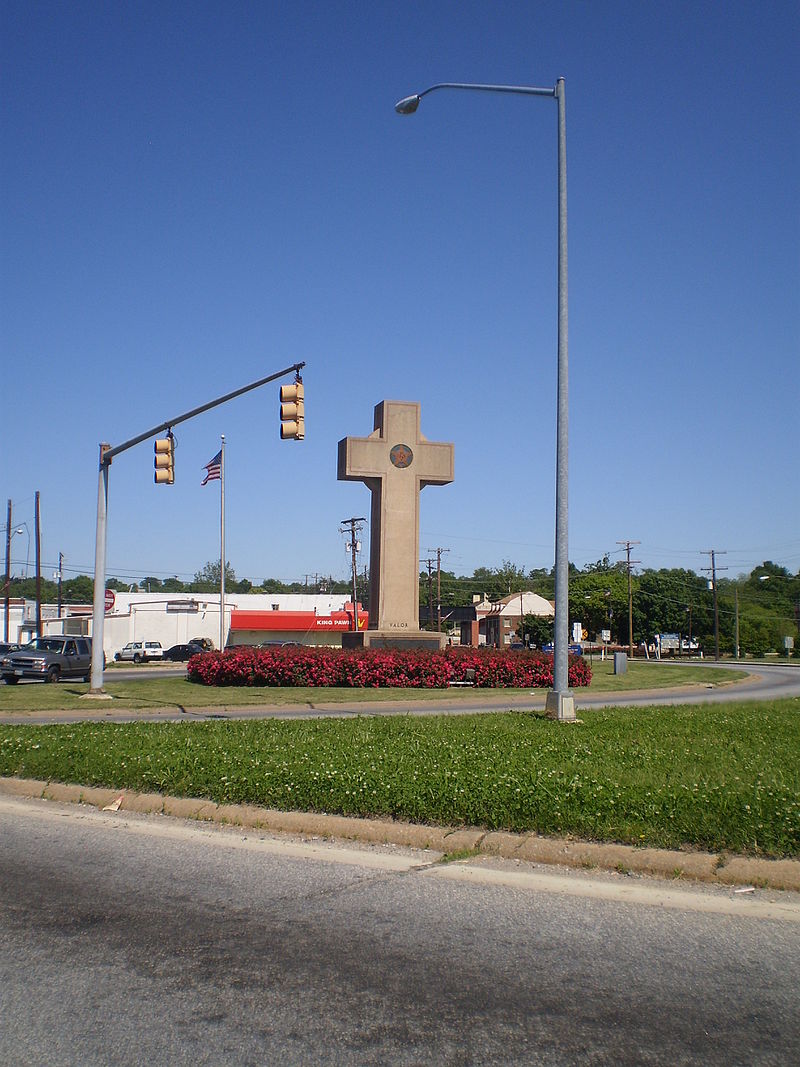Argument preview: Justices to consider constitutionality of cross-shaped war memorial on public land


Editor’s Note: An earlier version of this post ran on December 10, 2018,, as an introduction to this blog’s symposium on The American Legion v. American Humanist Association, as well as at Howe on the Court, where it was originally published.
Over the years, the Supreme Court has sometimes struggled to explain when and why religious symbols are permitted in the public sphere and when they are not. Next Wednesday, the justices will hear oral argument in a dispute over the constitutionality of a cross that sits on a traffic median in the suburbs outside Washington, D.C. The challengers say that the cross is an illegal government endorsement of Christianity, while its defenders counter that the cross is simply a secular war memorial. The justices’ eventual opinion will likely decide the fate of the cross, but the ruling could also clarify – or potentially even revamp – the Supreme Court’s test for resolving these kinds of challenges.
The Constitution’s establishment clause bars the government from both establishing an official religion and favoring one religion over another. In 1971, in a case called Lemon v. Kurtzman, the Supreme Court struck down state programs that provided financial support for private schools, including religious ones. At the same time, the justices also outlined a test for courts to use to determine whether a government law or practice violates the establishment clause. They concluded that the law or practice will pass constitutional muster if it has a secular purpose, its principal effect does not advance or inhibit religion, and it does not create an “excessive entanglement with religion.”
Since then, the court has both tweaked the Lemon test and criticized it, with the late Justice Antonin Scalia famously comparing it to a “ghoul in a late-night horror movie that repeatedly sits up in its grave and shuffles abroad, after being repeatedly killed and buried.” And in a 2005 case called Van Orden v. Perry, the court rejected an establishment clause challenge to the display of a Ten Commandments monument on the grounds of the Texas state capitol without relying on the Lemon test.
Because Justice Stephen Breyer served as the crucial fifth vote to leave the monument in place, his concurring opinion in Van Orden provided the governing rule for the case. Breyer declined to apply the Lemon test, stressing that there is “no single mechanical formula that can accurately draw the constitutional line in every case.” Instead, he explained, judges should “exercise legal judgment,” staying “faithful to the underlying purposes of the” establishment clause and taking “account of context and consequences measured in light of those purposes.” In particular, he observed, the establishment clause does not require the government to remove all traces of religion from the public sphere. “Such absolutism,” he emphasized, “is not only inconsistent with our national traditions, … but would also tend to promote the kind of social conflict the establishment clause seeks to avoid.”
Breyer acknowledged that the Ten Commandments monument on the grounds of the Texas state capitol “undeniably has a religious message,” but he added that the context in which the monument was displayed indicated that the state intended the monument to convey a secular message. And the fact that the monument had been on the capitol grounds for 40 years without any challenges, Breyer continued, suggested that the public also regards it as “part of what is a broader moral and historical message reflective of a cultural heritage.”
The cross at the heart of the current case was erected in Bladensburg, Maryland, to honor 49 soldiers from Prince George’s County, Maryland, killed during World War I. In 1922, the local American Legion post took over responsibility for the project after the private organizers ran out of money; the fundraising drive included a Christian prayer for the invocation. When the 40-foot-tall cross was finished in 1925, the dedication ceremony featured only Christian prayers, with no other religions represented.
In 1961, the state government acquired the cross and the land it sits on, due at least in part to concerns about safety as traffic around the cross increased. The cross is part of a larger park honoring veterans that also contains much smaller memorials remembering the War of 1812, World War II, the Korean and Vietnam Wars, and the September 11 attacks. The symbol of the American Legion – a small star inscribed with “U.S.” – appears at the top of the cross, while a plaque at the bottom contains the names of the fallen soldiers and a quote from President Woodrow Wilson.
The plaintiffs in the case are local residents who are offended by the presence of the cross on public land, along with the American Humanist Association, a group that describes itself as a “non-profit organization that advocates to uphold the founding principle of separation of church and state.” They contend that the presence of the cross on government land and the state’s maintenance of the cross violate the Constitution’s establishment clause, and they asked a federal district court to order the state to either remove the cross or alter the monument so that it is no longer in the form of a cross.
The district court rejected the plaintiffs’ plea. In its view, the state’s involvement with the cross had less to do with religion than with maintaining traffic safety and honoring veterans.
The challengers appealed to the U.S. Court of Appeals for the 4th Circuit, which reversed. Using the Lemon test, the court of appeals ruled that the cross violates the establishment clause because it “has the primary effect of endorsing religion and excessively entangles the government in religion.” First, the court of appeals explained, it was impossible to “ignore the fact that for thousands of years the Latin cross has represented Christianity.” The cross is part of a larger park that includes other war memorials, but the cross is so much larger and more prominent than the other war memorials that “the historical meaning and physical setting of the Cross overshadows its secular elements.” Therefore, the court of appeals concluded, the average citizen “would fairly understand the Cross to have the primary effect of endorsing religion.”
The court of appeals found that the cross also violated another prong of the Lemon test: The cross creates “excessive entanglement” with religion because the state owns and maintains the cross on public property and does so in a way that suggests that the state “either places Christianity above other faiths, views being American and Christian as one in the same, or both.”
Both the American Legion (which entered the case to defend the cross) and the state asked the Supreme Court to review the 4th Circuit’s ruling. They warned that allowing the lower court’s decision to stand would endanger not only the Bladensburg cross, but other war memorials as well – including two crosses commemorating World War I at Arlington National Cemetery – and the American Legion lamented what it described as the “confused state of this Court’s Establishment Clause jurisprudence.” Meanwhile, a federal appeals court in Atlanta characterized the court’s establishment clause cases as a “hot mess” even as it concluded that the presence of a cross in a Florida park violates the Constitution. On November 2, the justices announced that they would take up the case.
The state points to the Supreme Court’s decision in Van Orden, and in particular Breyer’s concurring opinion, as confirmation that the cross does not violate the Constitution. The cross was constructed for a “wholly secular” purpose, the state contends: When you look at its “dedications, its inscriptions, its context, and nearly a century of practice,” it becomes “abundantly clear that this monument was erected to serve—and, for 93 years, has served—as a secular commemoration of American servicemen in World War I.”
The American Legion argues that all of the Supreme Court’s establishment clause tests have a common theme that focuses on “the importance of historical tradition and an objective assessment of the government’s reasons for putting up the display” – a standard that the cross can clearly pass. But the Legion urges the justices to go further and adopt a less stringent test that focuses on whether a religious display is consistent with the country’s historical traditions; if it is, there would be no violation of the establishment clause as long as the government is not “exploiting the tradition to coerce religious belief or observance by” people who are not religious.
Defending the 4th Circuit’s ruling, the challengers argue that the cross at the center of this case “sends a much stronger message of Christian favoritism” than a privately donated creche in a courthouse, which the Supreme Court has already deemed unconstitutional.
In the challengers’ eyes, the 4th Circuit’s decision is squarely in line with the Supreme Court’s other cases on religion because the entire picture, history, and context of this cross all point to the cross being an endorsement of Christianity, rather than conveying a secular message.
What the American Legion is really asking the Supreme Court to do, the challengers stress, is to “overturn decades of Establishment Clause jurisprudence in favor of a” rule that would allow religious displays as long as the government isn’t trying to coerce or convert anyone. But the court can stick with a much simpler rule, the challengers tell the justices: There is general agreement that the government violates the Constitution when it uses religious symbolism that “has the effect of endorsing religious beliefs, and the effect of the government’s use of religious symbolism depends on its context.”
When the justices hear oral argument and then decide the case, there are two different things to watch for. The first, obviously, is whether the cross will survive, or whether the court will instead find that it is unconstitutional. The second question is how broadly the justices will rule. Will they issue a narrow opinion that resolves this case and future cases that are very similar, but without saying much more? Or will they instead issue a more comprehensive decision that provides more extensive guidance about when religious symbols are permitted in the public sphere, possibly even jettisoning their old establishment clause rules in favor of a new rule, as the American Legion as suggested? Given Chief Justice John Roberts’ penchant for “judicial minimalism” generally and what seems to be a recent effort by the court to try to avoid more controversial issues, a narrower opinion seems more likely, but we’ll have a better idea soon enough.
* * *
Past cases linked to in this post:
Lemon v. Kurtzman, 403 U.S. 602 (1971)
Van Orden v. Perry, 545 U.S. 677 (2005)
[Disclosure: Goldstein & Russell, P.C., whose attorneys contribute to this blog in various capacities, is counsel on an amicus brief in support of the petitioners in this case. The author of this post, however, is not affiliated with the firm.]
Posted in Merits Cases
Cases: The American Legion v. American Humanist Association, Maryland-National Capital Park and Planning Commission v. American Humanist Association
